The recent decade has vividly demonstrated that we live in a data-driven world. IDC predicts that by 2025 the “global data sphere” will grow steadily row and reach 175 ZB. More informative decisions made with the help of analytics-focused applications based on the analysis of vast data have become essential to every second organization. However, as new technologies, such as the Internet of Things, continue to advance, the demand for enhanced analytical solutions continuously increases. One of the newest trends that are steadily coming to the fore is Augmented Analytics software, which is often referred to as the future of Business Intelligence.
Augmented Analytics Software is a tool that collects, processes, and analyses data, presenting it in a user-friendly way. It applies AI technology to the BI, helping users to easily prepare and clean their data, discover valuable insights, and easily share them within their organization.
Gartner refers to augmented analytics as “the next wave of disruption in the data and analytics market that leaders should plan to adopt.”

Augmented Analytics Software and Covid-19
The outbreak of Covid-19 has posed new challenges for most businesses. The major ones are the uncertainty of the current situation and abrupt changes in business logistics. With current business models and historical data gradually becoming obsolete, the Corona crisis triggers a need for significant behavior and economic shifts.
To successfully operate in these uncharted waters, most companies rely on strong data practices that allow them to make well-grounded estimates of the current situation and reach more informed decisions. Augmented Analytics software with applied AI assists companies in numerous processes, such as forecasting customer demands, determining crisis strategies’ effectiveness, finding potential supply-chain disruptions, identifying at-risk employees, etc. But most importantly, Augmented Analytics software helps companies to identify the most relevant challenges, adjust their policies, and prepare for the future.
Read more about various IT solutions to Covid-19.
Augmented Analytics Software: Analytics, AI, ML, and NLP
What sets Augmented Analytics software apart from other Business Intelligence software is the convergence of such technologies as Data Analytics, Artificial Intelligence (AI), Machine Learning (ML), and Natural Language Processing (NLP).
Data Analytics
Data Analytics is the core of every Business Intelligence (BI) application. Applying statistics, operations research, and mathematical tools, data analytics software determines patterns in data that allow companies to make well-grounded decisions on the basis of collected and generated information.
According to MicroStrategy 2018 Global State of Enterprise Analytics Report, 90% of enterprise analytics and business professionals currently refer to data and analytics as the key to their digital transformation initiatives.
Artificial Intelligence
Augmented Analytics software is at the fore in the AI-driven trend. With embedded Artificial Intelligence technology, the software automatically cleans, and parses collected data, eliminating human errors and user biases by analyzing data without human intervention. Once the insights have been gleaned, the Augmented Analytics software automatically distributes insights across the system via a wide range of integrated functions, including in-app messaging, chatbots, mobile apps, and virtual assistants.
According to Gartner’s research:
“Augmented analytics uses machine learning/ artificial intelligence (ML/AI) techniques to automate data preparation, insight discovery and sharing. It also automates data science and ML model development, management and deployment.”
Read more about how AI is used in Augmented Analytics.
Machine Learning
Machine Learning (ML) technologies have come to replace the outdated BI systems that can no longer cope with increased volumes of data came to rescue. Machine Learning is a method of data analysis that allows Augmented Analytics to automate the selection and preparation of data. Moreover, with ML, Augmented Analytics software can continuously learn from the input data without human intervention and, as a result, identify trends and make predictions based on historical data.
In 2018 The McKinsey Global Institute performed an analysis of the value created by embedding machine learning in analytics across 400 enterprise use cases and found that this technology has the potential to create as much as an additional $15.4 trillion in value by 2020.
Natural Language Processing
Natural Language Processing (NLP) is another valuable element of Augmented Analytics software. It is responsible for automatically processing raw complex data into natural language text. NLP is a text analytics technology that transforms unstructured text into normalized documents and databases. It provides an efficient way to query data, generate visuals, and answer questions that lead to strategic insights for companies.
NLP allows to “identify specific items of information in documents – like date, order number, and policy number – so they can be categorized and analyzed.”- Accenture.
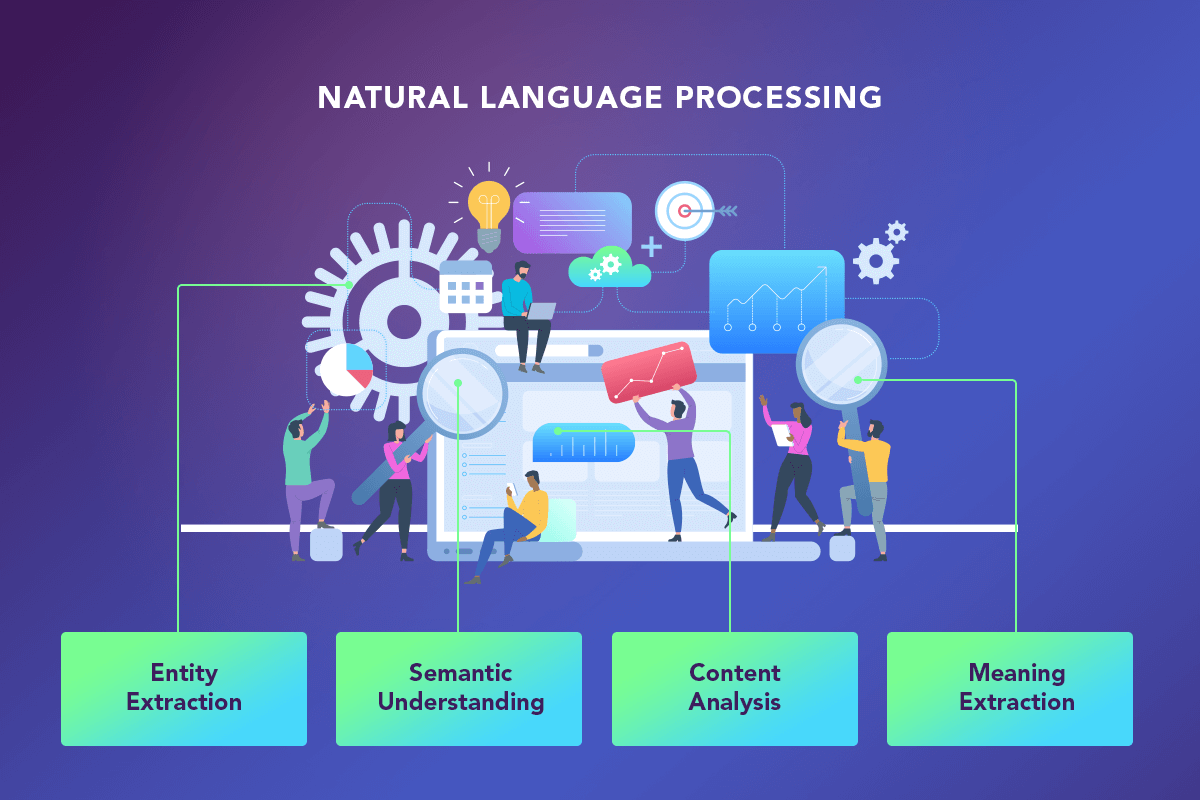
Applications of Augmented Analytics
With overwhelming volumes of daily incoming and outcoming data and correspondence, large organizations and medium-sized businesses often struggle to properly analyze and derive useful insights from this content and gain a clear view of the current business situation. Augmented Analytics Software offers several opportunities to help companies effectively understand and use the data content to support decision-making and operational efficiencies.
Anomaly and Trend Detection
Analyzing current and historical data from metrics such as clicks, CPM, impressions, reports, etc. With its embedded AI technology, Augmented Analytics software detects anomalies and trends in companies’ operations. As a result, executives can, for instance, prevent significant budget drains and performance losses, improve compliance and risk management, drive internal operational efficiencies, and increase sales.
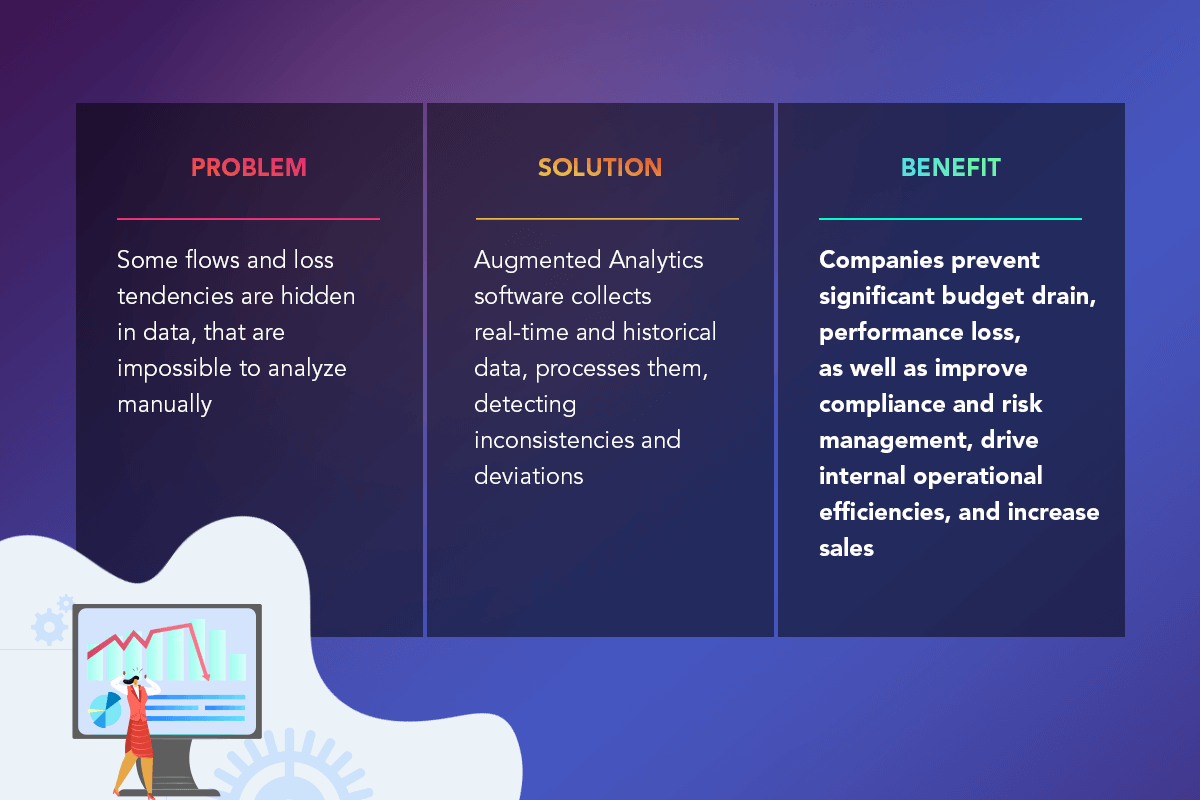
Segment Analysis
Based on such metrics related to geography, devices used, social media interaction, and user age, Augmented Analytics software can provide an analysis of the chosen segment and an insight into the company’s performance in a particular sector. All processed information is visualized in graphs, forms, and charts that enhance user understanding. With Augmented Analytics software, companies can promptly detect any market changes and their business missteps, reacting swiftly and decisively.
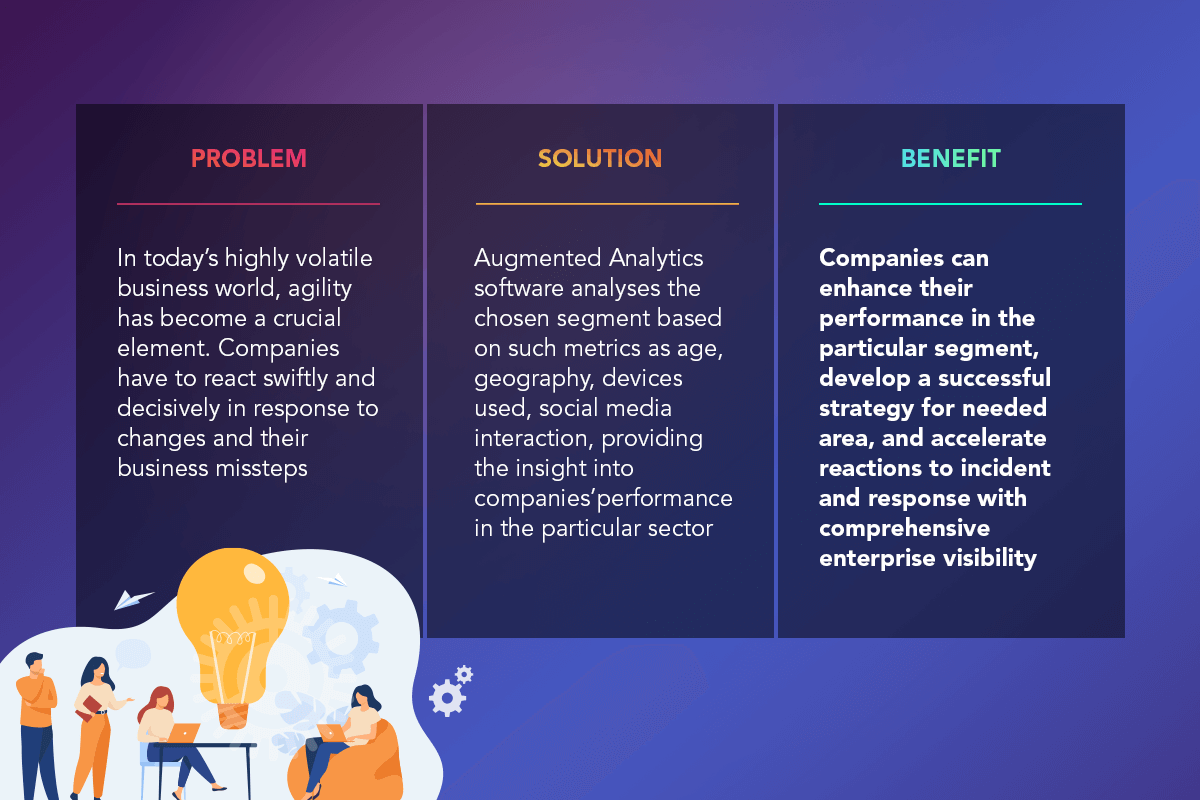
Budget Suggestions
It is not just speed that matters. Better decision-making is another important aspect of any business. Augmented Analytics software, with its AI capabilities, provides smart suggestions based on processed internal and external data. Embedded AI technology can also suggest smart budget allocation based on analyzing company resources and goals.
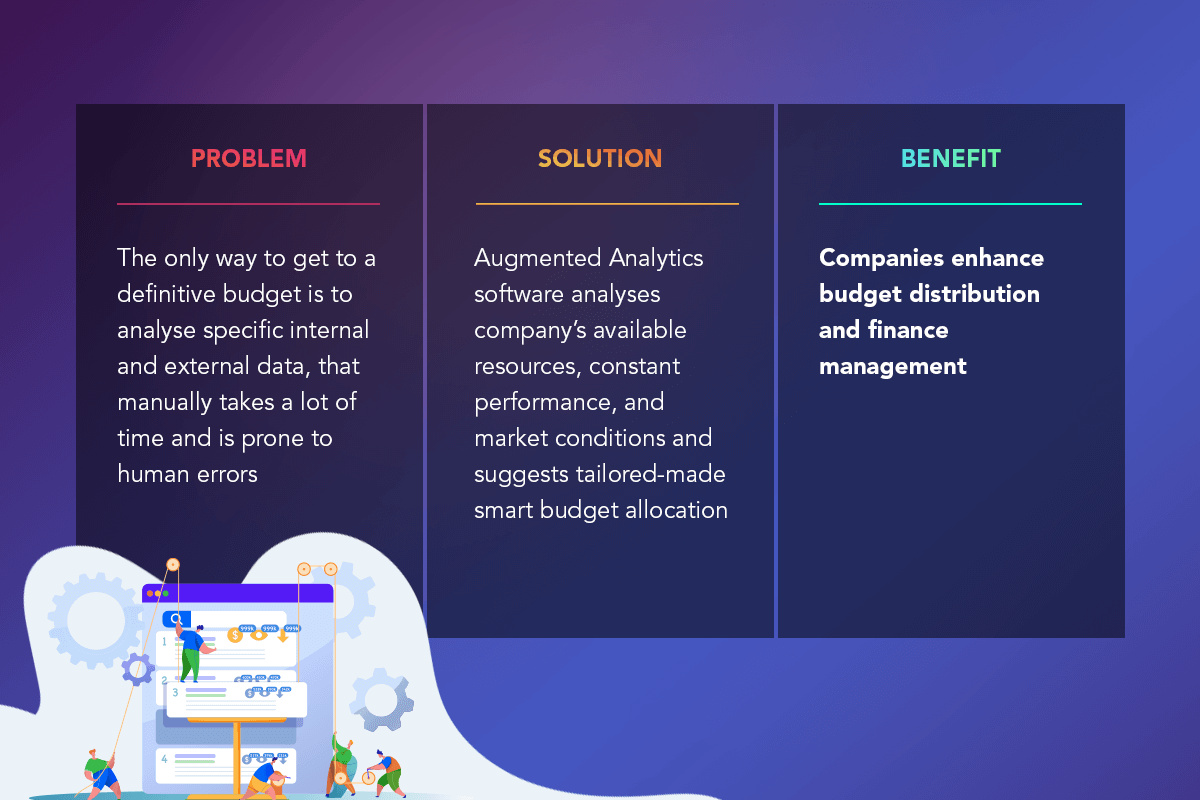
Performance Forecasting
Due to AI and ML capabilities, Augmented Analytics software can compare the company’s past performance, budget spent, and market conditions against the current challenges and make short- and long-term forecasts of operation future scenarios.
According to the Accenture TechVision 2018 report, 79% of executives are basing their most critical strategic decisions on data.
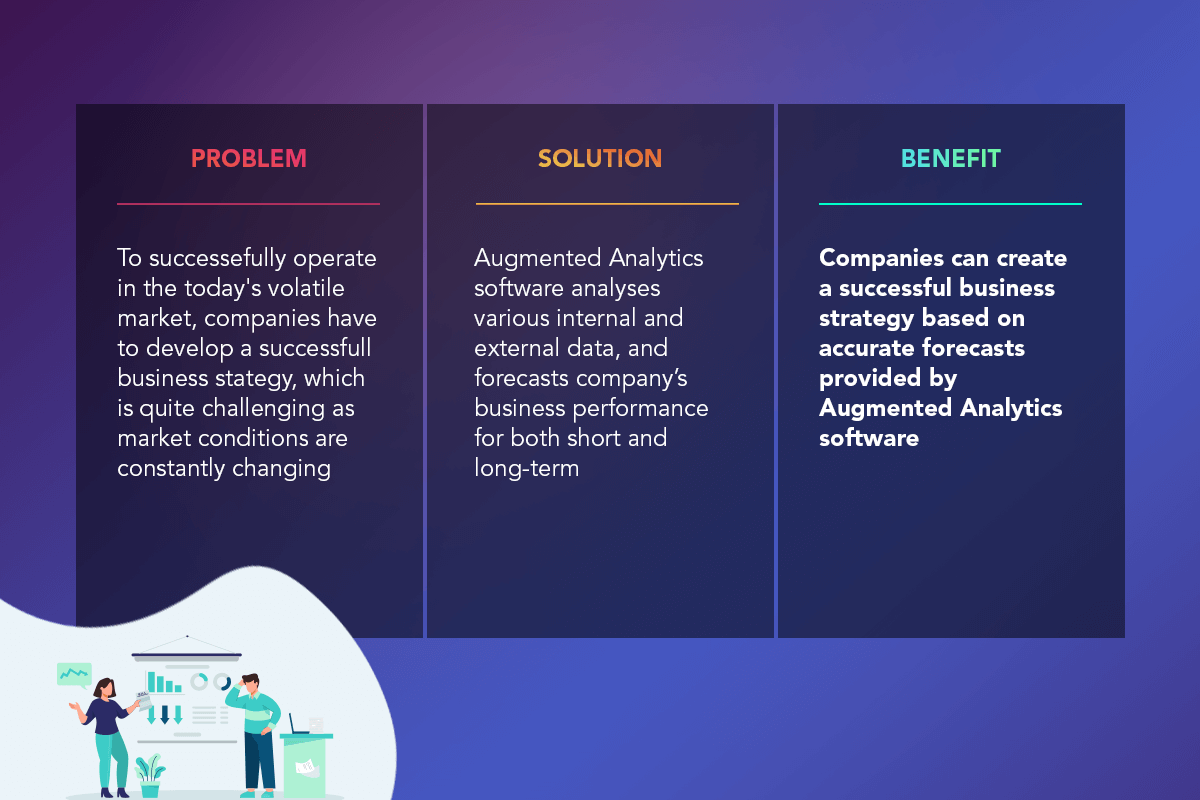
Who is Using Augmented Analytics Software?
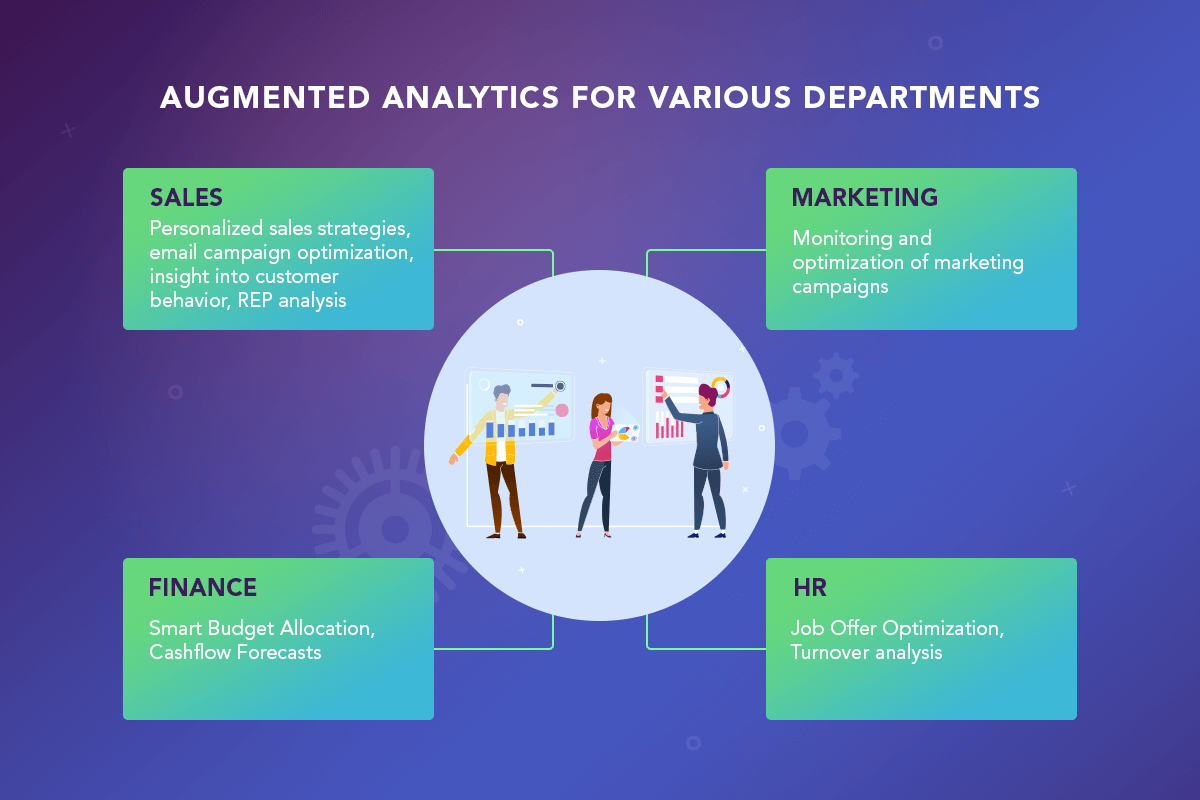
Sales
Sales teams widely use Augmented Analytics Software to keep track of sales trends and attract new clients. For instance, when a company gains a new prospective lead, Augmented Analytics Software can suggest the most effective sales strategy to reach it. Moreover, by analyzing behavior data, the software can determine the best time for contacting potential customers, ensuring they read the received email. Augmented Analytics technology can also analyze RFPs (Requests for Proposal), gaining and structuring all requirements, thus making it easier for employees to process the received requests.
Marketing
Augmented Analytics Software provides significant benefits for marketing departments. The software shows how a particular campaign is doing in a given region in real time and uncovers the opportunities for campaign optimization and business growth.
Finance
Besides smart budget allocation, Augmented Analytics Software offers cash flow forecasts for financial departments. With AI technology, Augmented Analytics estimates the amount of money that will move in and out of business within a short-term period, for instance, next week or month. The software will notify if a company needs to cut overheads, look for new investments, or focus on generating sales.
HR
HR applies Augmented Analytics to optimize their job offers and attract the best candidates for available positions. Using AI, Augmented Analytics software suggests what content job offers must contain and when to post them. Moreover, it can provide historical charts of up to six months of employee turnover, identifying the reasons behind it.
Augmented Analytics Use Cases: Softengi

Network Planning & Optimization for the Mobile Operator
Softengi has created a comprehensive augmented analytics model for monitoring and determining appropriate antenna angle and capacity. To determine the optimal positioning of antennas along with their best capacity, the Softengi application considers factors such as real-time weather conditions, events data received from social media, data about antenna angles, network coverage, network usage in specific regions, and traffic.
Churn Management for the Mobile Operator
For a multinational telecommunication services company, Softengi has developed an application that, by using augmented analytics and ML techniques, reduces the churn of telco subscribers using augmented analytics.
The application analyses internal and external information, such as customer profiles, rebate history, data from call centers, weblogs, product usage, and network experience. The Augmented Analytics application segments customers and suggests customized action plans for churn reduction.
Augmented Analytics for Procurement
Softengi has created Augmented Analytics software for optimizing multiple procurement processes and making procurement data more transparent for company employees.
By applying AI algorithms, the software detects cost drivers using cause-effect analysis, forecasts spend volume, models the outcomes of price or exchange rate fluctuations, and identifies the reasons behind material price variance.
Benefits of Using Augmented Analytics
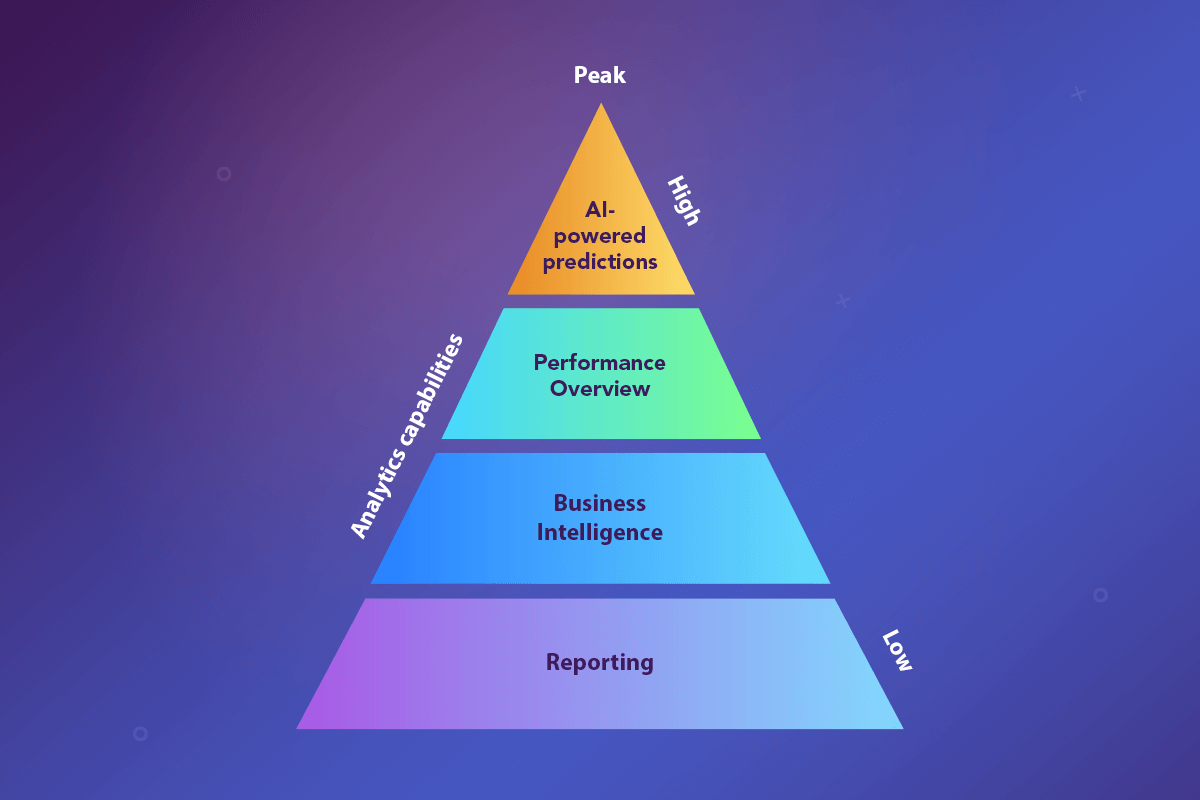
Acceleration of Data Preparation and Data Visualization
Most traditional analytics software requires manual support from data scientists in preparing and cleaning resource-intensive data. Augmented Analytics software, in comparison, automatically processes data without human intervention, saving time and money for companies.
Advanced Insights for a Clear View
AI allows Augmented Analytics software to gain insight into customers’ behavior, sales processes, and product inventory by analyzing and scaling internal and external data. As a result, companies gain a better vision of their performance in the market and can make more informative decisions.
Identification of Problems, Trends, and Barriers
Self-serve Augmented Analytics empowers companies to detect operational problems, market trends, and business barriers, providing support for strategic issues and helping employees to focus on critical projects.
Forecasts and Predictions for a Better Business Strategy
Augmented Analytics provides complex, sophisticated ML techniques that allow us to make accurate forecasts about future events. It provides metrics to ensure that the right decisions are made and that the business takes appropriate actions about products and services, competition, pricing, and other crucial business issues.
Smart Data Visualization
With Augmented Analytics software, gained data are visualized in a more transparent, intuitive, and contextual way in the form of charts, graphs, and tables. As the software analyses data in real time, an intuitive dashboard shows all information in user-friendly forms, constantly updating it. As a result, visual presentation of data enhances users’ data comprehension and decision-making.
Final Word
Today, we live in a world of data, which forces modern businesses to apply data-focused solutions in their operations. Augmented Analytics software is the most advanced analytics-driven application, which integrates cutting-edge technologies such as Artificial Intelligence, Machine Learning, and Natural Language Processing technologies. A self-serve Augmented Analytics software provides advanced insights into business performance and market conditions, makes accurate forecasts, and suggests actionable business strategies.




